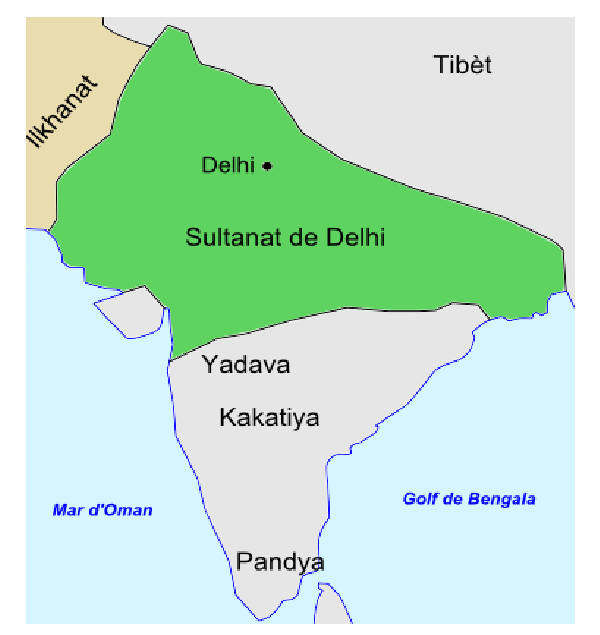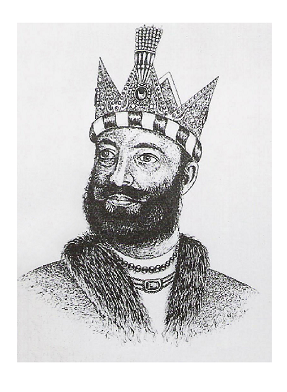

In the early years of Muslim rule in the Arab, the ruler was referred to as the Sultan because he held the authority and sovereignty. But with the coming of Seljugh sultans in 1055-1152, the word was converted into a title given to the supreme rulers. The caliph who was considered successors of the Prophet lost their importance during this period due to the split in their followers, which paved the way for the rising of several dynasties and the ultimate decline of the caliphate under Muslim rule. Although the first sultanate was established in 961, it was consolidated by Mahmud of Ghazni.

Delhi Sultanate
Nicolas Eynaud, CC BY-SA 3.0 lt;https://creativecommons.org/licenses/by-sa/3.0>, via Wikimedia Commons
During the eighth century, when the western countries were getting weaker, the Muslim rulers of Arab took this opportunity to invade Europe and Persia. They conquered Spain, which proved advantageous for them as it opened doors for them to other countries of the world.
With the capturing of Spain, the Arabic rulers began to gain trade access to south Asian countries along with China and Africa. This also led to the expansion of the Islamic Empire in Europe and Middle Eastern countries, which paved the way for the rise of the Ottoman Empire in Turkey. And Africa also turned into an Islamic colony by the tenth century.
Apart from territorial expansion and trade relations, the ideas of art and culture were also getting exchanged. For example, the Mughals, who ruled India, made so many architectures in India with Turkish style.
The Sultan is an Arabic term that connoted religious or moral mastery.
Later this term began to be used for political authority in Islamic Empire. By the 11th century, it became a title for the Muslim supreme authority.
The Islamic ruler, known as the first sultan was Mahmud of Ghazna. Later on, the Sultan title became common under the Seljuqs of Anatolia and Iran.
Subsequently this title was regularly granted by caliphs to Muslim rulers in Islamic Empire.
Maulvi Abdurab Ahadi, Public domain, via Wikimedia Commons
After the death of Prophet Mohammed (the spiritual head of Islamic land), his successors came to be known as caliphs. From the 11th to 13th century the caliph acquired the status of an Emperor and sultans became governors in these Islamic empires as kings and princes.
The title of the caliph was slowly passed down to sultans mainly during the Ottoman conquest of Egypt under Sultan Selim I. In fact, all Ottoman sultans were recognized as leaders of the Islamic state. After this, the Shaybanid in Turkistan, Gujarat Sultanate, the Mughal Empire of India, and the Morocco Sultanate accepted their Ottoman sultan as Muslim Caliphs.
The decline of the Ottoman caliphate started with the rise of Turkish nationalists and the weakening of Ottomans. They took charge of the Ottoman Caliphate, and made it an official party, leaving the Caliph as merely a figurehead similar to the Queen of England.
Mustafa Kemal made efforts to preserve caliphate rule and he even thought of proclaiming himself as the caliph. In fact, the kings of Egypt wanted to assume the caliphate. However, neither the British nor other Muslims did not let it happen and due to this British pressure, the caliphate was abolished on March 3, 1924, by the government in Ankara. All people belonging to this dynasty were deported. The last caliph, Sultan Abdülmecid, lived in France for 20 years. Finally, the Ottoman Empire was dissolved and the Turkish Republic rose to power.
During the ninth century, the Abbasid caliphate uprooted Ummayads and established its throne and transferred its capital to Baghdad. After Harun al Rashid, the last strong caliph of Abbasid. This Empire began to decline due to the following reasons −
Weakening of Baghdad’s control over distant land − The successors of Harun al Rashid were weak and could not maintain the empire. Besides, no clear succession policy also led to a civil war between supporters of his two sons. This further intensified factionalism and set the stage for Turkish slave officers(Mamluk) to rise to power.
Rising conflict between Pro-Iranian and Pro-Arab − Several new dynasties began to appear during this period like the Tahirids, Samanids and the Tulundis etc.
The remaining power of the Abbasids ended in 945 when one of the Shiite clans, Buyids, captured Baghdad. They kept the Abbasid caliph as a figurehead during their reign.
Therefore, from the 10 to the 13th century there was no individual political authority in Islamic society, but they were tied together with common cultural beliefs, which included Arabic as a language of high culture and free flow of traditions and ideas due to the movement of scholars, artists, and traders, etc.
Simultaneously, the Turkish sultanate was rising in the 10th and 11th centuries. They were nomads, who used to seve as loyal slave officers to Abbasid, Ummayid, and Buyids, etc.
The Sultanate of Gaznavid was established in 961 and became more strong during the reign of Mahmud of Ghazni. Mahmud of Ghazni was not the rival of the caliphate system; rather he gained the title from the caliph itself. After Mahmud’s death, the Seljugh of Turks came to power and they continued to expand their empire in Asia.
The 9th century witnessed the rise and expansion of Muslim rule in different parts of the world. During this period the position of caliph also consolidated in the Ottoman Empire mainly in the Abbasid kingdom. Gradually, the prominence of the caliph began to reduce with the weakening of the Abbasid Empire. Ultimately, with the rise of the Turks, the caliphs were replaced by Sultans working as slave officers under these caliphs. Now the caliphs became nominal spiritual leaders and the ultimate power lay in the hands of Sultans. Some dynasties tried to revive the idea of the caliphate but failed to do so.
Q1. Who was Mahmud of Ghazni and how is he connected with Indian history?
Ans. Mahmud of Ghazni was the ruler of Afghanistan. He was a passionate Sunni Muslim, who looted the wealth of India and used that wealth to develop the culture in Ghazni, by making it the center of Perso-Islamic culture.
Q2. Who were the Ottomans?
Ans. Ottomans was one of the biggest and longest-ruling empires in the world. It stretched over the middle east, parts of Europe and Africa and ruled for almost six centuries. The capital of this empire was Constantinople. And it is also believed that the concept of modernity, including scientific discovery and inventions, originated from this empire.
Q3. Who were Sunnis and Shiites?
Ans. These are two sects of Muslims. The ones who follow the Prophet Mohammed are Sunnis whereas Shiias consider themselves as successors of Prophet Mohammed’cousin and son-in-law.
Q4. When and How did the rise of Islam take place in the Indian subcontinent?
Ans. Islam arrived in the Indian subcontinent in nearly the 7th Century BCE when Sind was taken over by the Arabs and later it spread to Punjab and other northern parts of India with the Ghaznavids and Ghorids invasion.